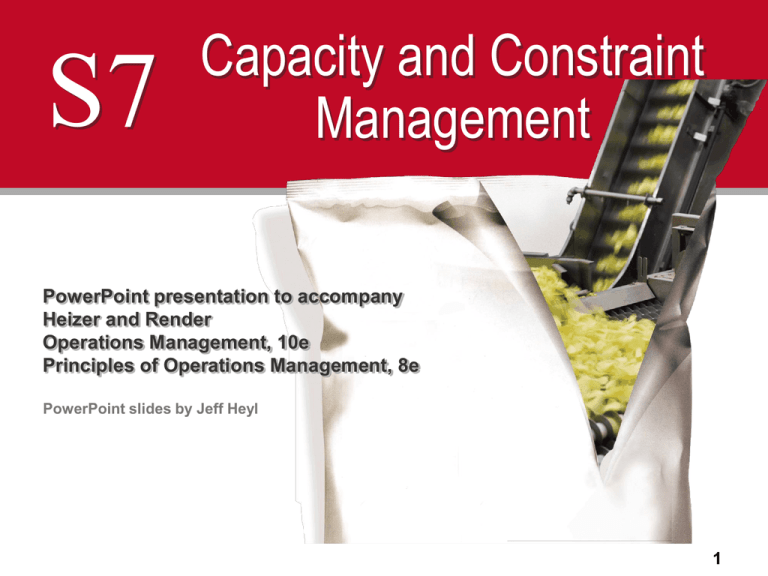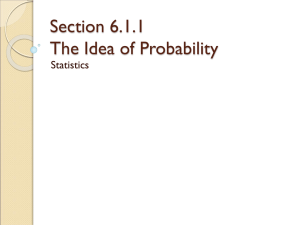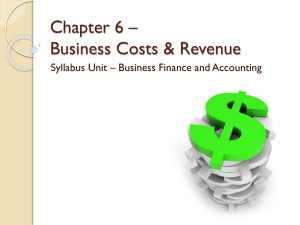Capacity and Constraint Management
advertisement

S7 Capacity and Constraint Management PowerPoint presentation to accompany Heizer and Render Operations Management, 10e Principles of Operations Management, 8e PowerPoint slides by Jeff Heyl 1 Outline Capacity Design and Effective Capacity Capacity and Strategy Capacity Considerations Managing Demand Demand and Capacity Management in the Service Sector Bottleneck Analysis and Theory of Constraints Process Times for Stations, Systems, and Cycles Break-Even Analysis 2 Learning Objectives When you complete this supplement, you should be able to: 1. Define capacity 2. Determine design capacity, effective capacity, and utilization 3. Perform bottleneck analysis 4. Compute break-even analysis 3 Capacity The throughput, or the number of units a facility can hold, receive, store, or produce in a period of time Determines fixed costs Determines if demand will be satisfied Three time horizons 4 Planning Over a Time Horizon Options for Adjusting Capacity Long-range planning Add facilities Add long lead time equipment Intermediaterange planning Subcontract Add equipment Add shifts Short-range planning * Add personnel Build or use inventory * Schedule jobs Schedule personnel Allocate machinery Modify capacity Use capacity * Difficult to adjust capacity as limited options exist Figure S7.1 5 Design and Effective Capacity Design capacity is the maximum theoretical output of a system Normally expressed as a rate Effective capacity is the capacity a firm expects to achieve given current operating constraints Often lower than design capacity 6 Utilization and Efficiency Utilization is the percent of design capacity achieved Utilization = Actual output/Design capacity Efficiency is the percent of effective capacity achieved Efficiency = Actual output/Effective capacity 7 Bakery Example Actual production last week = 148,000 rolls Effective capacity = 175,000 rolls Design capacity = 1,200 rolls per hour Bakery operates 7 days/week, 3 - 8 hour shifts Design capacity = (7 x 3 x 8) x (1,200) = 201,600 rolls 8 Bakery Example Actual production last week = 148,000 rolls Effective capacity = 175,000 rolls Design capacity = 1,200 rolls per hour Bakery operates 7 days/week, 3 - 8 hour shifts Design capacity = (7 x 3 x 8) x (1,200) = 201,600 rolls 9 Bakery Example Actual production last week = 148,000 rolls Effective capacity = 175,000 rolls Design capacity = 1,200 rolls per hour Bakery operates 7 days/week, 3 - 8 hour shifts Design capacity = (7 x 3 x 8) x (1,200) = 201,600 rolls Utilization = 148,000/201,600 = 73.4% 10 Bakery Example Actual production last week = 148,000 rolls Effective capacity = 175,000 rolls Design capacity = 1,200 rolls per hour Bakery operates 7 days/week, 3 - 8 hour shifts Design capacity = (7 x 3 x 8) x (1,200) = 201,600 rolls Utilization = 148,000/201,600 = 73.4% 11 Bakery Example Actual production last week = 148,000 rolls Effective capacity = 175,000 rolls Design capacity = 1,200 rolls per hour Bakery operates 7 days/week, 3 - 8 hour shifts Design capacity = (7 x 3 x 8) x (1,200) = 201,600 rolls Utilization = 148,000/201,600 = 73.4% Efficiency = 148,000/175,000 = 84.6% 12 Bakery Example Actual production last week = 148,000 rolls Effective capacity = 175,000 rolls Design capacity = 1,200 rolls per hour Bakery operates 7 days/week, 3 - 8 hour shifts Design capacity = (7 x 3 x 8) x (1,200) = 201,600 rolls Utilization = 148,000/201,600 = 73.4% Efficiency = 148,000/175,000 = 84.6% 13 Bakery Example Actual production last week = 148,000 rolls Effective capacity = 175,000 rolls Design capacity = 1,200 rolls per hour Bakery operates 7 days/week, 3 - 8 hour shifts Efficiency = 84.6% Efficiency of new line = 75% Expected Output = (Effective Capacity)(Efficiency) = (175,000)(.75) = 131,250 rolls 14 Bakery Example Actual production last week = 148,000 rolls Effective capacity = 175,000 rolls Design capacity = 1,200 rolls per hour Bakery operates 7 days/week, 3 - 8 hour shifts Efficiency = 84.6% Efficiency of new line = 75% Expected Output = (Effective Capacity)(Efficiency) = (175,000)(.75) = 131,250 rolls 15 Managing Demand Demand exceeds capacity Curtail demand by raising prices, scheduling longer lead time Long term solution is to increase capacity Capacity exceeds demand Stimulate market Product changes Adjusting to seasonal demands Produce products with complementary demand patterns 16 Complementary Demand Patterns Sales in units 4,000 – Combining both demand patterns reduces the variation 3,000 – Snowmobile motor sales 2,000 – 1,000 – JFMAMJJASONDJFMAMJJASONDJ Time (months) Jet ski engine sales Figure S7.3 17 Demand and Capacity Management in the Service Sector Demand management Appointment, reservations, FCFS rule Capacity management Full time, temporary, part-time staff 18 Break-Even Analysis Objective is to find the point in dollars and units at which cost equals revenue Fixed costs are costs that continue even if no units are produced Depreciation, taxes, debt, mortgage payments Variable costs are costs that vary with the volume of units produced Labor, materials, portion of utilities Assumes - Costs and revenue are linear 19 Break-Even Analysis – Total revenue line 900 – 800 – Cost in dollars 700 – Break-even point Total cost = Total revenue Total cost line 600 – 500 – Variable cost 400 – 300 – 200 – 100 – Fixed cost | | | | | | | | | | | – 0 100 200 300 400 500 600 700 800 900 1000 1100 | Figure S7.5 Volume (units per period) 20 Break-Even Analysis BEPx = break-even point in units BEP$ = break-even point in dollars P = price per unit (after all discounts) x = number of units produced TR = total revenue = Px F = fixed costs V = variable cost per unit TC = total costs = F + Vx Break-even point occurs when TR = TC or Px = F + Vx F BEPx = P-V 21 Break-Even Analysis BEPx = break-even point in units BEP$ = break-even point in dollars P = price per unit (after all discounts) x = number of units produced TR = total revenue = Px F = fixed costs V = variable cost per unit TC = total costs = F + Vx BEP$ = BEPx P F = P P-V F = (P - V)/P F = 1 - V/P Profit = TR - TC = Px - (F + Vx) = Px - F - Vx = (P - V)x - F 22 Break-Even Example Fixed costs = $10,000 Direct labor = $1.50/unit Material = $.75/unit Selling price = $4.00 per unit $10,000 F BEP$ = = 1 - [(1.50 + .75)/(4.00)] 1 - (V/P) 23 Break-Even Example Fixed costs = $10,000 Direct labor = $1.50/unit Material = $.75/unit Selling price = $4.00 per unit $10,000 F BEP$ = = 1 - [(1.50 + .75)/(4.00)] 1 - (V/P) $10,000 = = $22,857.14 .4375 $10,000 F BEPx = = = 5,714 4.00 - (1.50 + .75) P-V 24 Break-Even Example 50,000 – Revenue Dollars 40,000 – Break-even point 30,000 – Total costs 20,000 – Fixed costs 10,000 – | – 0 | | 2,000 4,000 | 6,000 Units | | 8,000 10,000 25 Break-Even Example Multiproduct Case BEP$ = where V P F W i F ∑ Vi 1x (Wi) Pi = variable cost per unit = price per unit = fixed costs = percent each product is of total dollar sales = each product 26 In-Class Problems from the Lecture Guide Practice Problems Problem 1: The design capacity for engine repair in our company is 80 trucks/day. The effective capacity is 40 engines/day and the actual output is 36 engines/day. Calculate the utilization and efficiency of the operation. If the efficiency for next month is expected to be 82%, what is the expected output? 27 In-Class Problems from the Lecture Guide Practice Problems Problem 5: Jack’s Grocery is manufacturing a “store brand” item that has a variable cost of $0.75 per unit and a selling price of $1.25 per unit. Fixed costs are $12,000. Current volume is 50,000 units. The Grocery can substantially improve the product quality by adding a new piece of equipment at an additional fixed cost of $5,000. Variable cost would increase to $1.00, but their volume should increase to 70,000 units due to the higher quality product. Should the company buy the new equipment? 28 In-Class Problems from the Lecture Guide Practice Problems Problem 6: What are the break-even points ($ and units) for the two processes considered in Problem S7.5? 29 In-Class Problems from the Lecture Guide Practice Problems Problem 7: Develop a break-even chart for Problem S7.5. 30







